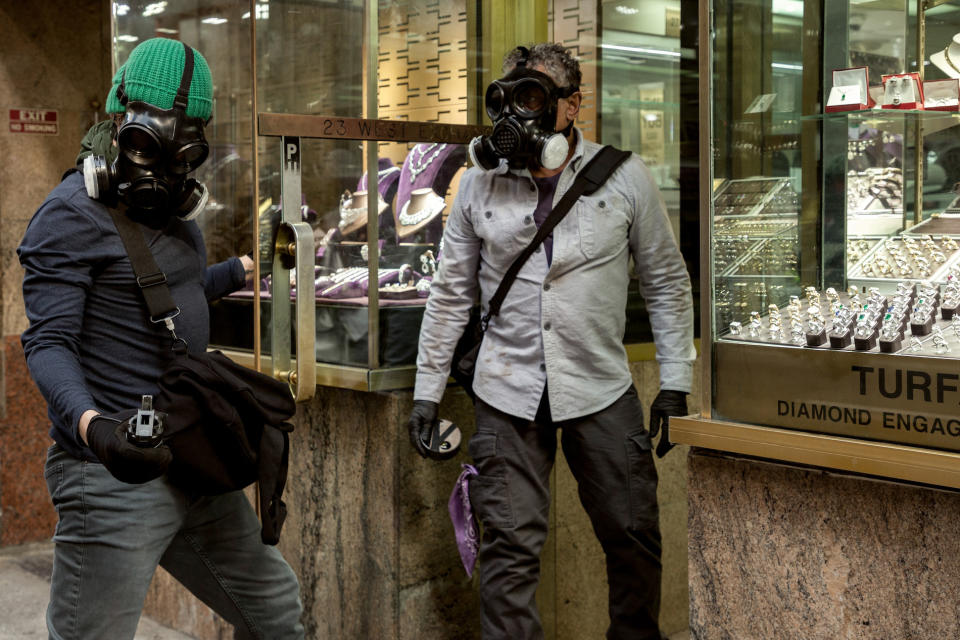Netflix’s ‘Kaleidoscope’ Unlocks a Watch-In-Any-Order Format for an Intriguing Heist Show

It seems like a lifetime ago, but in the early weeks of 2020, the then-named CBS All Access launched a show called “Interrogation.” The ten-episode season starred Peter Sarsgaard as a detective investigating a brutal murder where the accused killer was the woman’s son (Kyle Gallner). With a decent cast and a dour, decades-spanning saga, the idea was that viewers could share in the detective work and watch the show in any order they wanted. Following the clues at their convenience, they could hop around different years, suspects, and investigators to figure out what really happened that night in the early ‘80s.
Fast-forward a few years and the beginning of 2023 brings “Kaleidoscope,” a show that offers the same promise of TV-watching freedom, this time revolving around a massive ten-figure vault heist. Each episode is color-coded, offering any audience member a time-fragmented look at the lead-up to and the aftermath of the planned robbery. Chapters range from a 24-year flashback all the way to a “where are they now?” look set six months after the heist. The first seven of eight episodes are designed to watch in any order, leading up to a finale that shows what really happened during the theft.
More from IndieWire
Part of the fun of “Kaleidoscope” is watching the “assembling the team” montage spread out over a handful of episodes. Eventually, ringleader Leo Pap (Giancarlo Esposito) enlists longtime confidant Ava Mercer (Paz Vega) and former associate Stan Loomis (Peter Mark Kendall) as two of the main prongs in the biggest job of their lives. Their target? Roger Salas (Rufus Sewell), a hotshot security magnate who claims to have one of the most protected private storage areas in the world.
It’s a simple enough premise, key considering a high-concept storyline probably wouldn’t mesh well with the episode shuffling and flexibility that this format needs. There’s jealousy, revenge, regret, and redemption, all swirling around in a get-rich-quick effort where the criminals and the mark all have something to hide.

“Interrogation” had a starting episode and an ending episode, building interchangeable chapters in between based around suspects in a murder investigation. “Kaleidoscope” could easily have taken the same tack and built 45-minute chunks around each person involved in the job. Instead, the approach here from creator Eric Garcia and his writing team has a higher degree of difficulty in hiding details that remain satisfying in any order they’re revealed.
Based on this reviewer’s quasi-scientific experimentation, “Kaleidoscope” doesn’t only work chronologically. Watch multiple episodes in a row working backwards and there’s still a satisfying bit of keepaway being done on the part of Garcia and the writing team. The show is being billed as a puzzle, where every episode is a piece. In practice, the show is more like a safe with a pinpad code with each episode giving you a number to unlock the whole thing. Thematically, this purposefully hazy approach gels with a bunch of smugglers and hired hands, some of them working under aliases taken up after tragedies long since buried.
There is a distinction to be made, though, between whether the structural gambit of “Kaleidoscope” works (it does) and whether some of the more straightforward pieces here are successful (less so). Part of that stems from the idea that the show is, by design, vague about who all these people are and what drives them. Ray and Roger in particular feel like preludes to a backstory. They’re interesting in any version of the present, but there’s always a sense that something is being artificially held back as a surprise, not for the sake of the story but to preserve value for whatever order viewers choose to pick.
To the extent that this is a puzzle with individual pieces, each episode has a handful of details that are meant to be the notches showing where they fit in the overall story. They arrive as oddly specific asides or non sequiturs in conversations that can’t help but be clear hints or callbacks, depending on what point they arrive in. To the show’s credit, there are others that are slid in more subtly (including one of the series’ most effective twists that happens entirely off-screen). But that “hidden in plain sight” element that makes the best heist stories so effective gets robbed of its power every time the show reminds you of what’s being hidden. That includes the cheeky device in almost all of these episodes where the most pivotal pieces are the same color as the episode title. It’s an idea that’s fun in theory but starts to become a distraction in the episodes that do it most aggressively.

David Scott Holloway/Netflix
Aside from that bit of chromatic signifying, “Kaleidoscope” has a flattened aesthetic that robs the show a little bit of the time-hopping fun. With multiple directors here (including Robert Townsend), it’s up to the intro title cards to situate the viewer where on the timeline they are at any given point. One thing that an effective, more traditional TV season offers that’s conspicuously absent here is that sense of gradual build and the feeling of evolution that comes with an intentional order of discovered details.
That extends to the character work here, particularly as it relates to the members of Leo’s team. Each of them seem to have something other than the job itself keeping them locked into the team, but the up-in-the-air nature of the show order means that their motives feel pliable at any given moment. Romances get undercut, credentials get murky, and the heist itself loses that sense of specialization that makes the best of the “Kaleidoscope” peers feel like a magic trick. Instead, there’s much of the time here devoted to blunt objects (Jai Courtney’s brash, repetitive meathead Bob Goodwin being the inescapable poster boy) when something like this requires precision tools. And this isn’t even the best crime drama in the last five years to have a non-chronological timeline with color-themed episodes, fractal-based end credits, and a supporting performance from Esposito where he plays someone with a complicated relationship to a safe-cracker. (That would be “Jett.”)
As thin as these pieces can sometimes be, “Kaleidoscope” is still entertaining. Garcia and the team have enough misdirects up their sleeve that there are some fun surprises along the way, even if some of them are telegraphed. It’s also admirable how much melancholy and foiled plans there are here, particularly in a genre where it’s easy to lean on empty popcorn fun. Some of that comes from what Leo and the team are going for. Other times it comes from the distinct look on the face of people realizing that their life is about to change based on things happening entirely out of their control. This is an approach that requires multiple leaps of faith at key points, and “Kaleidoscope” does a decent job earning many of them.
A whole platform name change later and “Interrogation” is still available on Paramount+. Whether it was the limitations of subscriber numbers at the time or the confusion around how best to watch it, the show never made the kind of splash that its two central performances deserved. (Sarsgaard has rarely been better and Gallner’s on-screen transformation from a gangly teen to a hardened prisoner makes for one of the more impressive technical performances in recent TV history.) After no other high-profile TV projects took the bait in the few years since, the successes and shortfalls of “Kaleidoscope” prove why. Even if this new Netflix show narrows that gap, there’s still a tradeoff in making entertaining modular TV and great TV.
Grade: B-
“Kaleidoscope” is available to stream now on Netflix.
Best of IndieWire
17 HBO and HBO Max Original Series to Get Excited About in 2023
The Best True Crime Streaming Now, from 'Unsolved Mysteries' to 'McMillions' to 'The Staircase'
Sign up for Indiewire's Newsletter. For the latest news, follow us on Facebook, Twitter, and Instagram.

